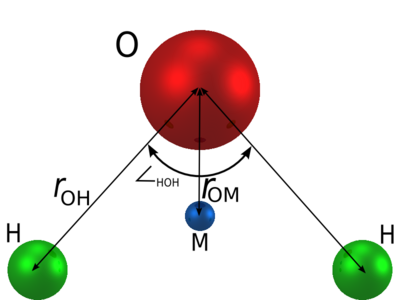TIP4PQ/2005 model of water: Difference between revisions
Jump to navigation
Jump to search
m (Updated reference link with a DOI.) |
Carl McBride (talk | contribs) m (Started a density maximum section.) |
||
| Line 14: | Line 14: | ||
| 0.9572 || 104.52 || 3.1589 || 93.2 || 0 || 0.5764 || -2q(H) || 0.1546 | | 0.9572 || 104.52 || 3.1589 || 93.2 || 0 || 0.5764 || -2q(H) || 0.1546 | ||
|} | |} | ||
==Density maximum== | |||
The TIP4PQ/2005 model has a density maximum in the liquid phase at 280K <ref>[http://dx.doi.org/10.1063/1.3239471 E. G. Noya, C. Vega, L. M. Sesé, and R. Ramírez "Quantum effects on the maximum in density of water as described by the TIP4PQ/2005 model", Journal of Chemical Physics '''131''' 124518 (2009)]</ref>. | |||
==References== | ==References== | ||
<references/> | <references/> | ||
Revision as of 10:25, 1 October 2009
The TIP4PQ/2005 model [1] is a re-parameterisation of the TIP4P/2005 potential for quantum path integral simulations of water, in particular for the ice phases. The difference between the TIP4P/2005 and the TIP4PQ/2005 models is the dipole moment, which increases from 2.305D to 2.38D thanks to the difference in the charges: TIP4P/2005 q(H) (e) is 0.5564 whereas for the TIP4PQ/2005 model this becomes 0.5764e.
Parameters

| (Å) | HOH , deg | (Å) | (K) | q(O) (e) | q(H) (e) | q(M) (e) | (Å) |
| 0.9572 | 104.52 | 3.1589 | 93.2 | 0 | 0.5764 | -2q(H) | 0.1546 |
Density maximum
The TIP4PQ/2005 model has a density maximum in the liquid phase at 280K [2].
References
- ↑ Carl McBride, Carlos Vega, Eva G. Noya, Rafael Ramirez, Luis M. Sese "Quantum contributions in the ice phases: the path to a new empirical model for water -- TIP4PQ/2005", Journal of Chemical Physics 131 024506 (2009)
- ↑ E. G. Noya, C. Vega, L. M. Sesé, and R. Ramírez "Quantum effects on the maximum in density of water as described by the TIP4PQ/2005 model", Journal of Chemical Physics 131 124518 (2009)




